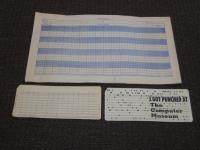Punch cards with a FORTRAN Coding Form
Donor: John David Stone
In the 1960s and 1970s, programs were punched on cards that they could be read into a computer. Each card contained one line of a program, with one character represented in each of 80 columns. Different punches represented different characters.
When programming in the FORTRAN programming language, specific columns of a card were used for different purposes. For example, columns 1 through 5 were used to assign a number to a statement in case it needed to be referenced elsewhere; a character in column 6 indicated the material on this card continued work started on the previous card; regular instructions or commands were placed in columns 7 through 72; and (optionally) sequencing information was placed in columns 73-80.
In order to keep track of what should be typed where, it was not uncommon for programmers to first write their programs on special coding forms. Each form allowed the writing of several lines (e.g., 24 lines in this case), and lines were divided into columns that corresponded to locations on a punch card.
This coding form was used by John Stone during a course he took in 1972. The blank punch card comes from the University of Iowa Computation Center, and the punched card from the Computer Museum, then located in Boston, MA.

